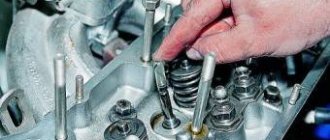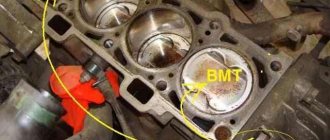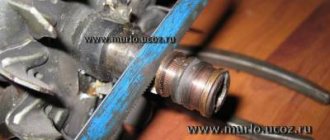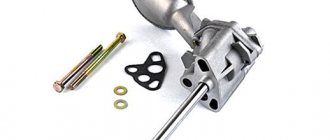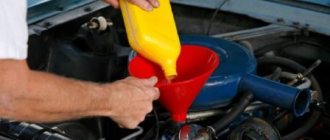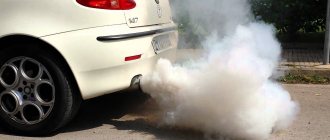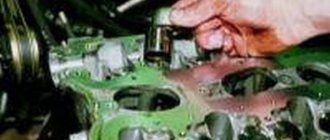Oil seals (valve seals) - malfunctions, signs of wear, replacement
Structurally, an internal combustion engine has several types of oil seals that serve as a seal for various moving joints, among which a special role is given to valve seals or, as they are also called, valve stem seals.
Valve seals for VAZ 2109
Purpose
Protection of the combustion chamber from oil ingress from the cylinder head. Oil is supplied to the cylinder head under pressure to lubricate the camshafts, during the rotation of which an oil mist is created in the head cavity, consisting of splashes of hot oil that settle on all elements of the cylinder head.
Where are they located?
The cylinder head contains guide bushings for the intake and exhaust valves. A certain thermal gap is left between the bushing and the valve stem, designed to allow the parts to expand when heated. To prevent oil from the block head from entering the combustion chamber through this gap on the bushings, seals are installed in the form of caps, which is why they got their name - “oil scraper caps”.
Valve seal location
Device
The oil seal is a steel cylinder for a rigid fit on the head of the guide sleeve. On top of the cylinder, a layer of rubber or rubber (fluorine or acrylate rubber) is vulcanized in the form of a truncated cone to tightly grip the valve stem and remove oil during its operating stroke. A spring ring is installed at the end of the cap to ensure reliable contact of the cap with the valve body.
When should you change?
When the power plant is operating, depending on the engine speed, the valves perform about 200-1200 strokes every minute, which negatively affects the service life of the caps, causing their natural wear. Car manufacturers do not provide any information on the frequency of replacing valve seals and this work is carried out as signs of their malfunction are detected.
Signs of malfunction:
• Oil on the spark plug threads; if the caps are heavily worn, oil is already present on their electrodes;
• Smoke coming from the muffler when warming up a cold engine and when revving;
• Decrease in power, deterioration in dynamics and increase in fuel consumption;
• Unstable starting of a hot engine;
When the engine overheats, it is the caps that are the first to suffer, as they are the highest located in the engine, plus those in contact with the valves, heated in the combustion chamber. In such cases, the seals simply “tan” and are no longer able to do their job, allowing oil to freely enter the combustion chamber.
On the left is a faulty valve seal.
Faulty seals can also be detected when opening the valve covers to perform adjustment work or replace the gasket. This applies to engines where the caps can be seen. The malfunction will be expressed in the absence of a spring, or an oil seal that has “removed” from the guide sleeve and “sits” on the valve stem.
How does the replacement process work?
On many engines, oil seals are replaced without removing the cylinder head, only partially disassembling it to get to the seals.
However, if the engine has been running for a long time with faulty caps, this will definitely lead to the formation of carbon deposits on the valve plates and seats, which must be removed for reliable engine operation.
Therefore, it is recommended to carry out the replacement by removing the cylinder head, where, if necessary, the valves will be cleaned and ground in to restore compression in the cylinders.
In addition, in most cases, the removed head reveals that its plane is not parallel, which needs to be milled.
In any case, this work is classified as complex and responsible and should be performed in a car service center, or in the garage of an experienced mechanic, where there are all the conditions and the necessary tools to carry it out.
In the photo, the replacement was made with the cylinder head removed
However, there is a nuance here. Replacement will be advisable only if the valve stem bushings are not worn. Otherwise, the service life of the new parts will be extremely limited and repeated repairs will be required.
The fact is that if the valve stem moves in the guide with a large gap, then it will not move in the center of the bushing, but with a skew and constantly put pressure on one edge of the cap, causing its intense wear.
What happens if you don't repair it?
As follows from the theory, the combustion of 1 liter of gasoline requires 14-16 kg of air, and such an air-fuel mixture will be the most favorable for engine operation, both in terms of fuel economy and full power output.
When oil appears in this mixture, this leads to incomplete combustion, unstable engine operation, loss of power and increased fuel consumption.
In addition, when oil burns, carbon deposits form on the valve plates, piston crown and spark plug electrodes. When there is a strong flow of oil, when the caps are no longer able to retain it, misfires occur, or one of the spark plugs stops working altogether.
Carbon deposits on valves are one of the consequences of faulty caps
The deposits that appear on the valve plates do not allow them to “sit” tightly into the valve seats, which leads to a decrease in compression in the cylinders and interruptions in the operation of the power plant. Plus, a loose valve fit (especially exhaust valves) creates conditions for the breakthrough of hot gases from the combustion chamber and burnout of the valve disc.
If the above listed malfunctions are detected, it is recommended, without delaying until the next day, to contact car service professionals to extend the engine’s life.
Why does smoke appear from the exhaust pipe?
To understand the reasons for the appearance of such a problem, you need to plunge a little into the principle of operation of the internal combustion engine, remember what processes occur in it. To ignite a flammable mixture, it must be compressed. This is done in the cylinders by a piston on which piston rings are installed for sealing. Friction occurs between the piston, rings and cylinder walls. To reduce wear of rubbing parts, engine oil is supplied to their working area. Wear of the oil scraper ring is the culprit for oil entering the combustion chamber.
The second way engine oil can enter the combustion chamber is through the gap between the valve and the guide sleeve.
To prevent oil from entering the fuel combustion zone, the valve stem and guide bushing are sealed using valve stem seals. When the material from which the valve seals are made loses its elasticity, oil enters the cylinder. But it also happens that both malfunctions coincide; engine oil penetrates into the cylinder through worn rings and through hard valve stem seals.
Valve seals or rings: how to determine what caused the blue smoke
If you've done a quick study of the issue, you've probably noticed that there is a lot of conflicting information. For example, there is a lot of controversy around the same compression: some argue that with normal pressure in the cylinders there is no reason to go into the piston, others insist that this is not an indicator at all in the current situation. And regarding the relationship between the engine temperature, the position of the gas pedal and the time of appearance of bluish smoke, it is not at all clear what’s what.
Let us immediately note that there is no connection between compression and defective oil scraper rings. Firstly, the rings that scrape oil from the cylinders wear out or become stuck first, while the compression rings continue to work as expected. Secondly, even with slightly worn compression rings and damaged oil scraper rings, compression will be normal, since the oil remains on the cylinder walls.
At the same time, unspoken differences exist that make it possible to determine what exactly has failed: caps or oil scraper rings. The difference is that each group of parts produces blue smoke at different intervals.
Symptoms of problems with caps
In the old days, stiff or worn valve seals were indicated by a puff of bluish smoke that burst out of the exhaust pipe immediately after starting the engine. By the way, these observations have not lost their relevance today. Even in this situation, it would be a good idea to ask how much the work costs and what else needs to be changed when replacing the valve stem seals on the engine.
The following test will help you accurately judge the caps for replacement:
- Warm up the engine to operating temperature.
- Let the engine run for 5-7 minutes while warm.
- Sharply depress the gas pedal for 5-10 seconds and watch the exhaust gases at this moment.
If there are problems with the seals, in the first seconds of the “gas to the floor” mode, a cloud of smoke with a bright bluish tint flies out of the muffler. For extra confidence, repeat the attempt to throttle to failure 2-3 more times. Observations are such that in subsequent cycles the puff of smoke will lose saturation, and may even disappear altogether.
For your information. The most reliable diagnosis is considered to be based on the color of the exhaust, in which “gas to the floor” is given after warming up and running the engine at operating temperature for 5-7 minutes. The bluish tint under such conditions turns out to be much more saturated than during the morning start and other gas conditions.
What explains this prioritization? If the cap is worn, oil will flow down the valve stem when the engine is running. Whether it will accumulate on the valve plate or immediately enter the cylinders is determined by the angle of the throttle valve. So, at idle, the speed of the air mass is low, the oil is not removed from the plate, but continues to accumulate. As soon as you sharply (it is important to press this way) press the gas pedal, air or the fuel-air mixture (depending on the type of fuel injection) draws the accumulated oil emulsion into the cylinders and it burns, forming a bluish smoke.
Functions of oil scraper rings
The main function of such rings is to remove heat from the piston. Otherwise, this threatens the piston with various defects - for example, burnouts or scuffing, which leads to disruption of the operation of the spare part and the entire mechanism as a whole. As a result, the part will jam in the cylinder. Also, it is the oil scraper rings that determine how tight the combustion chamber is, and therefore minimize the ingress of gases from the crankcase into the cylinder and back. In addition, the way the mating elements are lubricated is adjusted. It is important to remember here that both a lack of oil and its excess can damage the engine.
Replacement step by step - help for an amateur
Decarbonization helps only in the case of carbon deposits, but if we are talking about wear, then only replacement will save you. You can do it yourself. We will need a special puller, a mandrel for pressing, a metal rod, and we still cannot do without tweezers and a desiccant. When purchasing new caps and rings, give preference to quality - look for original parts. Remember, if you get a fake, you can only enjoy the correct operation of the engine for a few thousand kilometers. In addition, the coating of the upper rings is sometimes selected to match the engine material. And the compression and oil scraper elements must match the material of the cylinder liner. If the replacement is made with cheaper analogues, the result may be negative.
The next step in replacing oil scraper rings and caps will be to dismantle the components and mechanisms to provide access to the parts. The air filter is removed first, then the fuel pump. Don't forget about the ignition distributor. To dismantle the drive housing for auxiliary units, it is necessary to disconnect the bolted connection, then remove the negative terminal from the battery and the toothed pulley from the camshaft. Next, to get to the cylinder head cover, remove the mass drive. Lastly, the nuts securing the front and rear camshaft bearing housings are unscrewed.
The position of the camshaft key cannot be ignored; if it is not seated tightly enough, it must also be removed, otherwise it may be lost. Now we have free access to the camshaft itself, we take it out and the oil seal. Now we unfold the part so that the piston is at TDC, and, having removed the spark plug, insert a metal rod into the resulting hole, otherwise the valve will fail. Then we compress the valve springs with a special tool and remove two crackers using tweezers. Press out the rings using a tool.
Now installation. We remove the springs from new spare parts so as not to damage them. Before installation, do not forget to lubricate the elements with engine oil. We press the part in and put the springs in place. Installation of oil scraper rings should be carried out strictly in the reverse order. When installing medium ones, it is very important not to mix up the sides, otherwise oil consumption will increase significantly.
Why is oil intensively consumed?
In a working engine, valve stem seals and rings are responsible for removing residual lubricant from the valve stem and cylinder walls, respectively. At high speeds, the performance of this process decreases, but in general, oil consumption does not exceed the norm prescribed by the manufacturer. For some it is 1 l/10,000 km, for others it is 0.3 l/10,000 km, and still others may not add anything at all between service intervals, since they do not turn the engine above 3,500 rpm.
Naturally, when lubricant consumption suddenly increases, say, to 1 l/1,000 km, and even blue smoke comes out of the exhaust, this is a signal of a violation of the oil scraper functions. There are several reasons for this:
- The oil scraper rings are stuck.
- The caps have become stiff.
- The valve guides are worn out.
As a result, it would be nice to determine without disassembly which particular group of parts failed. Whether this is possible is the topic of the next paragraph.
Diagnostic methods
So, if your engine is smoking, how can you figure out whether the rings or caps are faulty? It is not necessary to resort to computer diagnostic methods. There are two simple tests to identify the source of the problem:
- Worn oil seals can be easily identified by watching the car in motion using the rear-view mirrors. Once you have gained speed, release the gas pedal, allowing the car to slow down naturally. Then, sharply press the gas while watching the rear of the car in the mirror. If, when you press the gas, blue or bluish-white smoke comes out of the pipe, then the culprit is the stiff valve caps, which have ceased to cope with their function. For the second method, you will need to wait for the engine to cool down. Then, in neutral gear, begin to gain engine speed. Blue smoke from the chimney = replacement of caps. The least painful option for the wallet.
- Failure of the rings can only be recognized when it is hot. As a rule, they show themselves when the load on the engine increases. For example, when driving uphill or suddenly accelerating when overtaking. If, when performing these actions, you are left with a persistent oily trace of black or bluish color, everything is very bad. In the best case, if the piston rings are faulty, you will need to add engine oil more often than usual. Then the rings can lie down and repairs of this kind are commensurate with a major overhaul of the engine. An indirect sign of ring wear is a weakening of engine power when the car begins to “go hard”.
Diagnostics using compression
The above problems with the power unit can be identified through special diagnostics using a compression meter.
This is a device that measures pressure. You can do such diagnostics in your garage. To do this, you will need the help of a friend and the presence of the device itself.
To carry it out correctly, you need to adhere to the following algorithm. First you need to put the car in the garage and warm up its engine to operating temperature.
After this, disconnect the spark plug of the first cylinder and insert a compression gauge there. Using the starter, start the engine for a few seconds (crank the crankshaft), and remember the pressure that the device shows. Next, you need to pour no more than 20 grams of oil into the cylinder chamber and turn the crankshaft again. If the pressure in the first case is low, and in the second case it increases, then the problem is in the piston rings and they definitely need to be changed.
Next, the second and subsequent candles are removed, and similar manipulations are carried out.
As you can see, there is nothing complicated in such a diagnosis, but it helps to identify one of the problems with the appearance of smoke.
It is important to remember that loss of engine power at high speeds or loads also indicates that the piston rings are worn out.
The reason for the appearance of smoke of different colors from the exhaust pipe may indicate several problems in the power unit. If they are diagnosed on time, then large deviations in engine operation will not appear. If you start it, then serious breakdowns may occur, and large costs for their correction may occur.
Oil scraper rings are one of the most important engine components. What kind of parts are these, where they are installed and how to replace them - every car owner must know in order to help his iron friend at any time.
How to change valve stem seals and when is it necessary to do it?
Problems with the car's lubrication system are the most serious in terms of consequences for the engine. Often, after advanced diseases of the oil seals and valves involved in the distribution of oil in the engine, the death of the power unit occurs. Compression drops, cylinders depressurize, and oil begins to flow like a river. One of the common problems, especially on domestic engines and budget foreign cars, is failed oil seals, which are called valve seals in spare parts catalogs. This element prevents excess oil from passing into the valve system, where it subsequently burns out or sticks to the valves.
Malfunctions of valve stem seals (VVS) often cause serious problems. The engine begins to take on oil, compression in the cylinders decreases, and constant micro-explosions occur under the hood. These indicators often also indicate the need for major engine repairs, so do not confuse breakdowns. Sometimes unscrupulous service stations offer to carry out major repairs instead of a cheap replacement of caps, from which companies earn good money. The driver should be careful and not waste money on unnecessary services.
Features of operation and reasons for failure of valve stem seals
The caps are made of fairly durable and hard rubber. On engines of expensive foreign cars, they are made from really high-quality materials; the caps do not deteriorate throughout the life of the vehicle. On domestic cars, MSKs fail much more often. On some cars, you have to change the caps after 100-150 thousand kilometers, but there is no routine replacement of this equipment. Therefore, replacement often occurs only after problems occur. Valve seals fail for a number of reasons:
- low quality oil, mixing two different brands of lubricant, which are not recommended to be mixed;
- the use of various active additives that promise to clean the lubrication system of vehicles;
- long-term lack of operation of the unit, after which the seals simply crack;
- operating the vehicle for too long, which causes increased wear of all parts;
- the initially low quality of valve stem seals installed at the machine manufacturer's plant;
- self-installation of low-quality caps in order to save budget for repair work.
Carrying out work with cheap components or without special tools is a possible real problem. If you decide to change the valve stem seals yourself, get the necessary tools and buy normal, expensive valve seals. The best fit is factory equipment that matches your vehicle perfectly. If you decide to save money, we recommend that you do not undertake independent repair work at all. It is better to give the car to specialists to replace the MSK.
Preparing to replace valve stem seals - tools and materials
The preparatory work is quite simple - you just need to find the right tool and place to do the work. The place should be clean without a huge amount of dust. But at this point the requirements are not so stringent. The main tasks of the performer are the correct selection of tools, as well as the purchase of the caps themselves and some other automotive products to complete the task. In particular, for a high-quality change of valve stem seals, you will need the following set of purchases at a car store:
- directly the caps that are suitable for your car and are factory (preferably) or at least certified;
- valve cover gasket - during the process you will have to dismantle the cover; for installation you will need a gasket;
In a car store you will be offered to buy spare valve stem seals, because the rubber often breaks during installation. If you decide to buy non-factory options, it is really worth buying a couple of spare rubber devices, but often they will be superfluous. However, the cost of this element is very low, so you can fork out for a supply. You don’t need anything else to change the MSK, although a good store will offer a number of other tools, lubricants and devices.
The process of replacing oil seals - we do it ourselves
If you are not afraid to disassemble the engine and are confident in your mechanic skills, you can do the job yourself. To do this, it is enough to complete all the tasks according to the instructions and follow the instructions without deviating from the plan. However, if you have any difficulties or unclear points, it is better to call a specialist and entrust the completion of the process to him. Correct installation of valve seals is an important task in which it is better to avoid any mistakes. So, the process of replacing MSCs is as follows:
- remove the valve cover by carefully unscrewing the bolts securing it, throw away the old cover gasket;
- then set the engine to the TDC position for cylinders 1 and 4 (the upper dead zone can be done according to the instructions, or by spinning the wheel on a jack at fourth speed);
- unscrew the fourteen bolts (for a four-cylinder engine), but do not remove them, carefully remove the unscrewed block and place it to the side on a clean surface, keeping the bolts facing up;
- using a desiccant remover, remove the crackers and then remove the spring on the first cylinder, place everything on a clean surface;
- pull out the valve stem seal and install a new one in its place (you can use a tube to gently tap it and fit it in place);
All bolts should be tightened as carefully as possible. A broken bolt in the valve mechanism or valve cover will have very unpleasant consequences. It is enough to approach all processes with a certain degree of accuracy in order to avoid common mistakes. Use only high-quality components and tools; this will give you the opportunity for normal operation and correct installation of each module. After completing the procedure, start the engine, listen to its operation and test drive it. After replacing the MSC, monitor the oil level. The engine must not be allowed to consume excessive amounts of lubricant. You can visually see the process of replacing valve seals in the following video:
Let's sum it up
If your car starts to take on too much oil, there are two important things to pay attention to. The first is possible wear of the pistons or piston group of the power unit. The second is valve seals or valve stem seals. It is easier and cheaper to first check the second variant of the problem than to look for the possibility of testing and eliminating increased engine wear. In any case, an engine that is consuming oil should be inspected and repaired.
Whether to do the procedure for changing valve stem seals yourself or entrust it to specialists is entirely your decision. Use different information sources, read information about this system in the repair instructions for your car. If the machine is modern and has complex technologies, then it is not worthwhile to penetrate into the bowels of the engine without experience. This can cause serious damage and high costs. Have you ever had to change valve seals yourself?
How to understand that the caps need to be replaced and not the engine piston system
It is very easy to confuse the signs of drying out valve seals and the deterioration of the cylinder-piston group. In both cases, the problem matures after 200,000 km; it often occurs on used cars that were purchased without proper diagnostics. Moreover, fat burning and blue smoke are characteristic of both diseases. But hardened valve stem seals do not affect the compression ratio, which usually drops when the piston rings and the walls of the pistons and cylinders themselves wear out. If the car consumes too much oil (from 1 liter per 1000 km), but the compression in the cylinders is normal, then 90 out of 100, it’s the caps.
What's the result?
As you can see, the problem of increased engine smoke can be identified through initial diagnostics. In this case, you need to know how to check the oil scraper rings without disassembling the engine.
You can find out the cause of the smoke, valve stem seals or rings, using the methods described above with your own hands in a garage. Finally, we note that you should always monitor oil consumption and engine smoke and check the lubricant level in a timely manner.
It is important to understand that monitoring symptoms and quickly identifying the problem will further reduce the cost of repairs and avoid serious and rapidly progressing damage to the internal combustion engine.
Why do piston rings stick? The main signs for independently identifying a malfunction, diagnostics. Do-it-yourself decarbonization of piston rings.
Use of anti-wear, anti-smoke and other additives to reduce oil consumption. Pros and cons after applying the additive to the engine.
The reasons for the appearance of carbon deposits in the combustion chamber, what is carbon deposits. How to clean engine pistons and combustion chamber from carbon deposits, cleaning without disassembling the engine.
When is it necessary to replace piston rings? How to install rings on the piston when replacing it yourself. Service life, rings, grinding in and running in.
Low compression in engine cylinders: the main reasons. How to increase engine compression without engine repair, available methods. Tips and tricks.
Carbon formation and consequences of engine coking. The occurrence of piston rings, the appearance of deposits and varnish on parts. How to remove carbon deposits yourself.
Diagnosis of faulty engine oil rings
As stated above, if the engine smokes black, then the problem is that the piston oil rings are worn out and lubricants are leaking into the combustion chamber.
Ignoring this problem can lead to the fact that the rings will not remove the lubricant, and therefore it will need to be constantly refilled. In addition, the rings may become stuck and will need to be decoked. You can learn how to decarbonize stuck rings from other publications. But it is better to do this at a specialized service station.
Now let's move on to consider the question of how to diagnose this problem.
There are two ways, the first is a compression test, which will be discussed in detail below.
The second is diagnostics with the power unit running.
In order to determine the problem with the rings, it is imperative to warm up the engine to operating temperature, since this problem only appears when the power unit is running hot.
Then press the gas pedal, giving standard or increased speed. If black smoke comes from the exhaust pipe, then the problem is in the rings and they need to be replaced.
How to replace the piston rings in this case. Here you will have to disassemble the cylinder head, remove the pistons, buy a new set of rings and replace them. If the car is foreign-made, then it is better to entrust such work to specialists, since doing this without removing the engine will be problematic.
It is important to remember that if the problem is in the rings, then the engine will generally have difficulty starting after a long period of inactivity.
